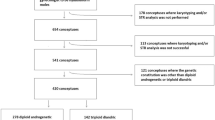Summary
Cytogenetic and biochemical polymorphisms have been used to determine the origin of a tetraploid conceptus. Genetic polymorphisms were found in chromosomes 1, 6, 9, 15, 16, 22 and the sex chromosomes. The conceptus was found to have one maternal and three paternal contributions, indicating an origin other than a failure of cytokinesis at the first cleavage division of the zygote. The results presented are in favour of a trispermic origin of the conceptus.
Similar content being viewed by others
References
Angell RR, Jacobs PA, (1978) Lateral asymmetry in human constitutive heterochromatin: Frequency and inheritance. Am J Hum Genet 30:144–152
Boué J, Boué A (1973) Studies in spontaneous abortions. In: Boué A, Thibault C (eds) Chromosomal errors in relation to reproductive failure. Paris, INSERM, pp 29–56
Boué JG, Boué A (1976) Chromosomal anomalies in early spontaneous abortion. In: Grundmann E, Kirsten WH (eds) Current topics in pathology, vol 62. Developmental biology and pathology. Springer, Berlin Heidelberg New York, pp 193–207
Carr DH (1967) Chromosome anomalies as a cause of spontaneous abortion. Am J Obstet Gynecol 97:283–293
Carr DH (1969) Cytogenetics and the pathology of hydatidiform degeneration. Obstet Gynecol 33:333–342
Carr DH (1971) Chromosome studies in selected spontaneous abortions. Polyploidy in man. J Med Genet 8:164–174
Creasy MR, Crolla JA, Alberman ED (1976) A cytogenetic study of human spontaneous abortions using banding techniques. Hum Genet 31:177–196
Dhadial RK, Machin AM, Tait SM (1970) Chromosomal anomalies in spontaneously aborted human fetuses. Lancet 2:20–21
Evans HJ, Buckton KE, Sumner AT (1971) Cytological mapping of human chromosomes: Results obtained with quinacrine fluorescence and the acetic-saline-Giemsa techniques. Chromosoma 35:310–325
Gallimore PH, Richardson CR (1973) An improved banding technique exemplified in the karyotype analysis of two strains of rat. Chromosoma 41:259–263
Golbus MS, Bachman R, Wiltse S, Hall BD (1976) Tetraploidy in a liveborn infant. J Med Genet 13:329–332
Harris H, Hopkinson DA (1976) Handbook of enzyme electrophoresis in human genetics. North Holland Press 1976 and Supplements 1977 and 1978
Hassold T, Chen N, Funkhouser J, Jooss T, Manuel B, Matsuura J, Matsuyama A, Wilson C, Yamane JA, Jacobs PA (1980) A cytogenetic study of 1000 spontaneous abortions. Ann Hum Genet 44: 157–178
Honoré LH, Dill FJ, Poland BJ (1976) Placental morphology in spontaneous human abortuses with normal and abnormal karyotypes. Teratology 14:151–166
Jacobs PA, Hassold TJ, Matsuyama AM, Newlands IM (1978) Chromosome constitution of gestational trophoblastic disease. Lancet 2:49
Jacobs PA, Wilson CM, Sprenkle JA, Rosenshein NB, Migeon BR (1980) Mechanism of orgin of complete hydatidiform moles. Nature 286:714–716
Jacobs PA, Szulman AE, Hunt PA, Matsuura JS, Wilson CC (1982) Complete and partial hydatidiform mole in Hawaii: Cytogenetics, morphology and epidemiology. Br J Obset Gynaecol 89:258–266
Kajii T, Ohama K, Niikawa N, Ferrier A, Avirachan S (1973) Banding analysis of abnormal karyotypes in spontaneous abortion. Am J Hum Genet 25:539–547
Kajii T, Niikawa N (1977) Origin of triploidy and tetraploidy in man: 11 cases with chromosome markers. Cytogenet Cell Genet 18: 109–125
Kelly TE, Rary JM (1974) Mosaic tetraploidy in a two-year-old female. Clin Genet 6:221–224
Lawler SD, Fisher RA, Pickthall VJ, Povey S, Wyn Evans M (1982a) Genetic studies on hydatidiform moles. I. The origin of partial moles. Cancer Genet Cytogenet 5:309–320
Lawler SD, Povey S, Fisher RA, Pickthall VJ (1982b) Genetic studies on hydatidiform moles. II. The origin of complete moles. Ann Hum Genet 46:209–222
Ornoy A, Salamon-Arnon J, Ben-Zur Z, Kohn G (1981) Placental finding in spontaneous abortions and stillbirths. Teratology 24: 243–252
Pitt D, Leversha M, Sinfield C, Campbell P, Anderson R, Bryan D, Rogers J (1981) Tetraploidy in a liveborn infant with spina bifida and other anomalies. J Med Genet 18:309–311
Sumner AT (1972) A simple technique for demonstrating centromeric heterochromatin. Exp Cell Res 75:304–306
Szulman AE, Surti U (1978a) The syndromes of hydatidiform mole. I. Cytogenetic and morphological correlations. Am J Obstet Gynecol 131:665–671
Szulman AE, Surti U (1978b) The syndromes of hydatidiform mole. II. Morphologic evolution of the complete and partial mole. Am J Obstet Gynecol 132:20–27
Therkelsen AJ, Grunnet N, Hjort T, Myhre Jensen O, Jonasson J, Lauritsen JG, Lindsten J, Brunn Petersen G (1973) Studies on spontaneous abortions. In: Boué A, Thibault C (eds) Chromosomal errors in relation to reproductive failure. Paris INSERM, pp 81–93
Vassilakos P, Riotton G, Kajii T (1977) Hydatidiform mole: Two entities. A morphologic and cytogenetic study with some clinical considerations. Am J Obstet Gynecol 127:167–170
Yamamoto M, Fujimori R, Ito T, Kamimura K, Watanabe G (1975) Chromosome studies in 500 induced abortions. Humangenetik 29: 9–14
Author information
Authors and Affiliations
Rights and permissions
About this article
Cite this article
Sheppard, D.M., Fisher, R.A., Lawler, S.D. et al. Tetraploid conceptus with three paternal contributions. Hum Genet 62, 371–374 (1982). https://doi.org/10.1007/BF00304561
Received:
Issue Date:
DOI: https://doi.org/10.1007/BF00304561




